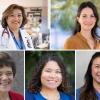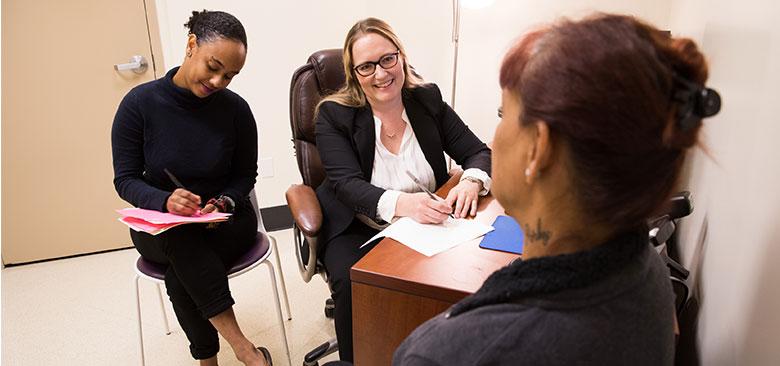
Chelsea Landolin, center, has spent two years examining how to improve health outcomes through more effective interprofessional education. (Photo credit: Elisabeth Fall)
What Will the 2020s Decade Have in Store for Health Care? Faculty Experts Weigh In
With the start of a new year and a new decade comes the promise of innovative advancements in health and health care. Here, seven faculty at the UCSF School of Nursing lay out their visions for what they are looking forward to in the 2020s — and the steps needed to advance human health and health care in our communities and beyond.
Chelsea Landolin, MS, RN, NP, Assistant Professor
Chelsea Landolin, MS, RN, NP, envisions a future in which interprofessional training and clinical practice are more deeply woven into the fabric of health education. This can be achieved through a variety of means, including further incorporating it into accreditation standards and incorporating it as part of training agreements with clinical sites where students are placed.
“Real clinical practice is very interprofessional, but students only get a small taste of that,” said Landolin, who, in 2016, implemented a program designed to ameliorate the psychiatric workforce shortage and improve health outcomes through more effective interprofessional education. “Each profession has its own style of problem-solving. It’s incredible what students learn from each other when they have interprofessional opportunities. The shortage of psychiatrists is going to have a profound impact on the way we practice. We need to enable other professions to pitch in to ensure everyone gets high quality care.”
Landolin hopes the new decade will bring key legislative changes that expand the role of nurse practitioners, enabling them to care for patients without a physician’s supervision — a need that grows increasingly urgent as the psychiatrist workforce — over 50 percent over the age of 55 — reaches retirement age.
Broader use of telehealth and technology, such as smartphone apps, virtual medical appointments and video visits, in both community behavioral health and community primary care will be key to making it easier for patients to connect with their providers. In particular, attention will need to be paid to safety net populations who often face barriers, such as lower rates of computer literacy, limited access to high-quality devices, and minimal or no Internet access, to taking full advantage of technological advances.
“What I’m hoping to see in the next decade is a much higher level of technological sophistication that enables us to meet the needs of today’s patients. We need to move away from the thinking that the patient has to do all the work to get the care they need — we need to meet them halfway,” she said.
Monica McLemore, PhD, MPH, Associate Professor
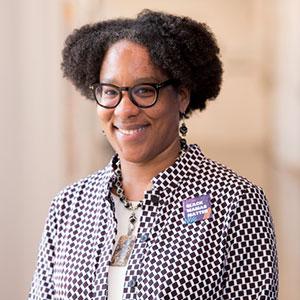 Monica McLemore Since 1987, maternal mortality has doubled in the U.S., with about 800 maternal deaths happening every year now. Monica McLemore, PhD, MPH, is driven to address the underlying factors, particularly for the most marginalized people, and reduce this troubling trend.
Monica McLemore Since 1987, maternal mortality has doubled in the U.S., with about 800 maternal deaths happening every year now. Monica McLemore, PhD, MPH, is driven to address the underlying factors, particularly for the most marginalized people, and reduce this troubling trend.
The racial disparity in the maternal mortality rates is striking, she said.
“Black women are three to four times more likely to die from pregnancy-related conditions and to bear the brunt of serious complications,” she said. “That risk is equally shared by all black women regardless of income, education or geographical location.”
We can do so much more to prevent maternal mortality, she said.
“Instead of blaming women for their own deaths, we should focus on better understanding the underlying contributing factors. These include a lack of data; not educating patients about signs and symptoms — and not believing them when they speak up; errors made by health care providers; and poor communication among different health care teams,” McLemore said. “We should invest in wider access to midwifery, group prenatal care, social and doula support, and other interventions that have been proven effective in multiple studies at improving maternal health outcomes.”
In the new decade, McLemore also wants to see abortion access integrated into primary care. Significant steps need to be taken to remove barriers, she said. These include removing medication abortion drugs from the FDA’s Risk Evaluation and Mitigation Strategy, training more physicians and advanced practice clinicians to perform abortions, and allowing nurse practitioners and other advanced practice clinicians to provide early abortions.
Van Park, PhD, MPH, Associate Professor
“Every 65 seconds, someone in the U.S. develops Alzheimer's disease, according to the Alzheimer’s Association. The number of Americans with Alzheimer’s disease and related 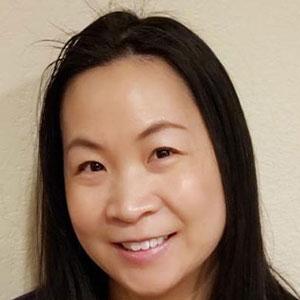 Van Park dementias (ADRD) is expected to increase from 55 million in 2019 to 88 million by 2050. These statistics are alarming, especially because there is no cure, prevention or treatment to slow the progression of Alzheimer's.
Van Park dementias (ADRD) is expected to increase from 55 million in 2019 to 88 million by 2050. These statistics are alarming, especially because there is no cure, prevention or treatment to slow the progression of Alzheimer's.
“With ADRD on the national agenda, we (policy makers, funders, researchers, community partners, providers, health and care systems, and other stakeholders) need to remember that our response, advocacy and research in ADRD needs to be inclusive of diverse populations. Such diverse populations include Asian Americans and Pacific Islanders (AAPI), who experience great disparities in health and health care due to a variety of factors including being underrepresented and understudied in research. A recent paper published in JAMA Network Open found that between 1992 and 2018, the National Institutes of Health devoted 0.17% of its total budget to clinical research focusing on AAPI. This is distressing when AAPI comprise nearly 7% of the U.S. population, and an even greater proportion in California (15%). Asian Americans are also the fastest growing racial group in the U.S.
“There are a variety of funding initiatives and projects that may help to reduce this disparity. Recently, a collaborative team of academic and community partners in California was awarded a NIH R24 grant to recruit and retain diverse AAPI in ADRD, aging, and caregiver-related research in a project called Collaborative Approach for AAPI to Research and Education (CARE).
“As we look into the future, health professionals such as nurses can help influence ADRD in education, policy and care, including culturally appropriate care. With the aging population in the U.S. and globally, ADRD is a significant priority in our health care system. The time to prepare and act is now.”
Elena Portacolone, PhD, MBA, MPH, Assistant Professor
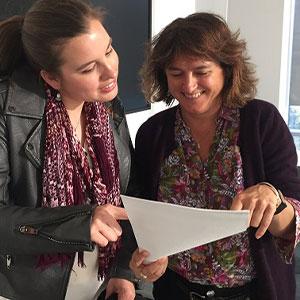 Elena Portacolone, right, is pictured with UCSF colleague Jalayne Arias (Photo Credit: Winston Chiong) “In this new decade, thinking about geriatric medicine, I look forward to seeing public home care aides being recognized as the pillars of our health care system. In particular, I would like to see that public home care aides are paid more, receive more training, reach a higher status, and become accessible to more older adults – not only those on Medicaid.
Elena Portacolone, right, is pictured with UCSF colleague Jalayne Arias (Photo Credit: Winston Chiong) “In this new decade, thinking about geriatric medicine, I look forward to seeing public home care aides being recognized as the pillars of our health care system. In particular, I would like to see that public home care aides are paid more, receive more training, reach a higher status, and become accessible to more older adults – not only those on Medicaid.
“Our School can contribute to further elevating the visibility of home care aide by publishing rigorous qualitative, quantitative and mixed-method research showing the impact of home care aides in the well-being of older adults, with an emphasis on those who are isolated, live alone and have chronic conditions, such as dementia.”
Elena Flowers, PhD, RN, Associate Professor
“The rate of discovery in the area of genomics and other -omics is rapidly outpacing our ability to integrate this information into clinical 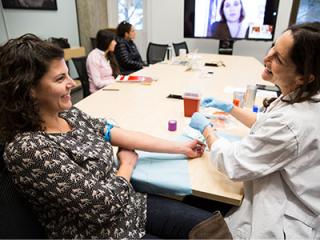 Elena Flowers, left, had her blood drawn in 2017 as part of her hands-on approach to understanding the implications of genomics profiling. (Photo credit: Elisabeth Fall) care in a practical and ethical way. These technologies have a firm footing in select disease areas for specific populations now, but I anticipate a much broader potential impact for common, complex diseases across the lifespan in the coming decade.
Elena Flowers, left, had her blood drawn in 2017 as part of her hands-on approach to understanding the implications of genomics profiling. (Photo credit: Elisabeth Fall) care in a practical and ethical way. These technologies have a firm footing in select disease areas for specific populations now, but I anticipate a much broader potential impact for common, complex diseases across the lifespan in the coming decade.
“Direct-to-consumer domains are sufficiently resourced and have made significant progress in the area of consumer education related to genomics and other -omics. In the coming decade, I hope to see these domains strengthen engagement with health care systems and providers in order to go beyond the “entertainment factor” and to meaningfully impact patient care.
“Nurses, having a primary role in patient education, have the capacity and potential to be key players in this transformation of patient care. Our challenge, as educators and researchers, is to find ways to prepare our nursing workforce to fill this need in the clinical care domain. This will require engagement of experts from the fields of clinical care, genomics, informatics, engineering and others. In the coming decade, I would like to see Advanced Practice Nurses prepared with training in all of these areas so that they are positioned to be leaders during this transformative time in health care.”
Jerry John Nutor, PhD, MS, RN, Assistant Professor
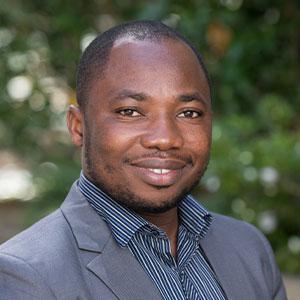 Jerry John Nutor “In the new decade, my hope is that we will be able to achieve progress on universal health coverage so that everybody — around the globe — is able to access health care and health services to stay healthy and alive. This is one of the goals of the World Health Organization for the decade, and it will help reduce the number of families who are pushed into poverty by lack of health care. I would also like to see more investment in population health - with this I don’t just mean overall health of a population but also equal distribution health to all people.
Jerry John Nutor “In the new decade, my hope is that we will be able to achieve progress on universal health coverage so that everybody — around the globe — is able to access health care and health services to stay healthy and alive. This is one of the goals of the World Health Organization for the decade, and it will help reduce the number of families who are pushed into poverty by lack of health care. I would also like to see more investment in population health - with this I don’t just mean overall health of a population but also equal distribution health to all people.
“We will also need increased interprofessional collaboration as we move into the new decade. Technology has taken over the world and we have to embrace that. We will want to collaborate within the health care profession and outside of it — with people in technology, engineering and other fields — to drive innovations forward that improve health.”
Promising health technology is already on the rise, Nutor said, such as in the form of mobile health trackers and telehealth appointments in developed countries. In Africa, home to the world’s fastest growing mobile economy, drones are used to deliver emergency medical supplies such as anti-snake bite venom and blood into rural areas in countries like Ghana and Rwanda. But more advancements are needed, and on a broader scale, to bring tech-fueled health care to underserved communities around the globe.
“We will have to be innovative and adaptive enough to ensure that we can reach people who cannot afford the technology,” Nutor said.
Wendy Max, PhD, Professor
“More care will be delivered by nurses – not just in primary care but also in specialty care – as we move toward a system that is based increasingly on value-based care. 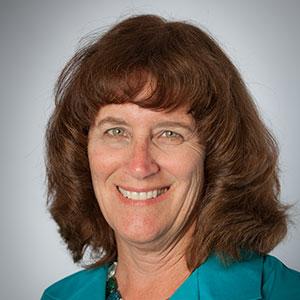 Wendy Max
Wendy Max
“The tobacco epidemic will be diminished as more restrictions on access to tobacco products by children are implemented. Tobacco products will be less appealing to users of all ages as flavors are restricted, but new products will be developed by the industry in an attempt to circumvent new restrictions. The impact of marijuana use on health will be better understood and raise new alarms.
“Technology will expand options for delivery of health care, as care can be delivered remotely via computer-based interactions between patients and providers, and health status can be monitored via wearables and other technological innovations. Ten years ago, who knew that we would all be wearing Fitbits and Apple watches today? Older adults will be able to remain in their homes with the use of these technologies that can monitor medication adherence, falls and more, but discussions related to Big Brother and privacy will become more frequent.”

